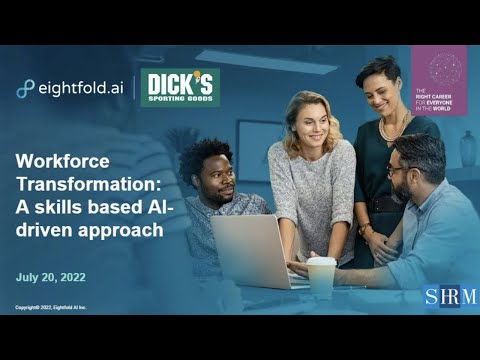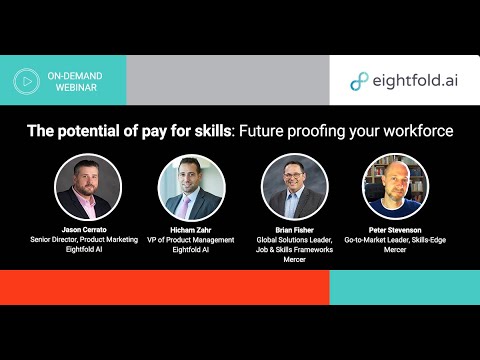Filters
The importance of hiring for skills and how AI can help
While it may be a new year, skills will remain a fixture of high-impact talent strategies for the foreseeable future. According to McKinsey, hiring for skills is five times more predictive of job performance than hiring for “check-the-box” qualifications like education and pedigree of previous employers. Without a talent strategy rooted in skills data, organizations are likely missing great opportunities to engage and promote extraordinary talent.
With a topsy-turvy economy and enough hiring freezes to cause an ice age, today’s market is highly unpredictable, and organizations are losing productive talent. And while some are weathering the storm, future disruption is inevitable. Without the right skills to adapt, organizations could fall behind.
Today, most technical skills are considered “perishable,” with a half-life of two to three years. We can almost see the “aging out” of skills in real time. For example, Eightfold Talent Insights shows that demand for drilling engineers (one of the most common jobs in the oil and gas industry) is plummeting, while demand for chemical and mechanical engineers (up-and-coming skills) is soaring.
This pattern persists across industries. Unfortunately, most organizations still need to dig themselves out of pandemic- and recession-induced skills gaps and catch up with this pace of change. Without action, these skills gaps will grow, and organizations will lag behind competitors taking a skills-first approach to managing talent.
To build a more agile workforce, it’s not enough to hire top talent. Skills change too quickly. Instead, HR teams need to invest in developing their existing workforce to help them gain the right skills for today and tomorrow. Here’s how artificial intelligence can give organizations real-time insights into the skills of their workforces, competitors’ workforces, and the overall market.
A skills-driven approach
Focusing on skills isn’t an entirely new concept. Competency models and skill taxonomies have been the go-to for quantifying people’s abilities and performance levels for years. But these static tools require too much time and manual effort to inform a successful talent strategy. When a consulting firm finishes the painstaking work of defining different roles and accompanying skill requirements, jobs have already changed to the point where the competency models are no longer valid.
With deep-learning AI, organizations can accelerate skills-driven talent strategies, gaining real-time insights into the skills of both internal and external talent. AI can analyze billions of global talent data points to determine employees’ and candidates’ skills and their potential to learn (or do more) with incredible accuracy.

Once talent managers can see their teams’ skills in real-time, they can drill into which skill gaps exist or might exist soon, then decide to bridge them with any combination of upskilling, reskilling, or hiring.
If talent managers go the hiring route, they can sit down with recruiters and define ideal candidates by breaking down jobs into must-have skills. AI helps recruiters jumpstart their search by sourcing top profiles from a prebuilt pipeline of current employees, contingent workers, previous applicants, and even company alums. Then, once recruiters post a job, AI screens résumés for those must-have skills, ranking the strongest matches first.
Deep-learning AI uses neural networks to gather information about the talent ecosystem, including the best candidates for a job, learning pathways for employees, and which contingent workers to redeploy. A talent intelligence platform’s dataset, consisting of millions or billions of data points, is essential for providing accurate recommendations about jobs and skills. The dataset should also be regularly updated to provide real-time insights about a person’s potential, career trajectory, and skills. It should also continuously update itself to provide relevant information and insights.
If talent managers choose to upskill, they can use AI to build personalized training paths for their teams by surfacing relevant courses, mentorships, and project opportunities. A transparent marketplace helps employees gain a much richer understanding of the career paths available, exposing them to the skills they need for open roles and experiences best suited to help them quickly upskill.
77% of business executives agree their organization should help their workers become more employable with relevant skills, but only 5% strongly agree they are investing enough in helping people learn new skills to keep up with the changing world of work. — The skills-based organization: A new operating model for work and the workforce, Sue Cantrell et al.
The benefits of a merit-based approach
It shouldn’t matter if a candidate is an ex-Apple employee, golfs with the CFO, or went to an Ivy League school. By moving the focus away from subjective success criteria, talent leaders can make decisions based on a person’s skills and potential, creating more equitable talent outcomes.
This potential-based approach helps organizations maintain an adaptable, skills-rich workforce ready for whatever is next. No matter how the economy changes, your organization will be better positioned to survive and thrive with the right strategy to cultivate and build skills. Making talent decisions based on accurate skill data is the best way to ensure smart talent decisions.

Carly Ackerman is the Director of Customer Experience for VIP & Partnership Accounts at Eightfold AI. Working closely with pioneering leaders, she has contributed to broad organizational and workforce transformations designed to meet the evolving demands of a disrupted global economy. Carly is a frequent speaker and thought leader on talent trends, workforce transformation, upskilling, and the employee experience.
To learn more about a skills-driven approach, read our new e-book, How to build an agile workforce with a skills-driven approach.
The post The importance of hiring for skills and how AI can help appeared first on Eightfold.

